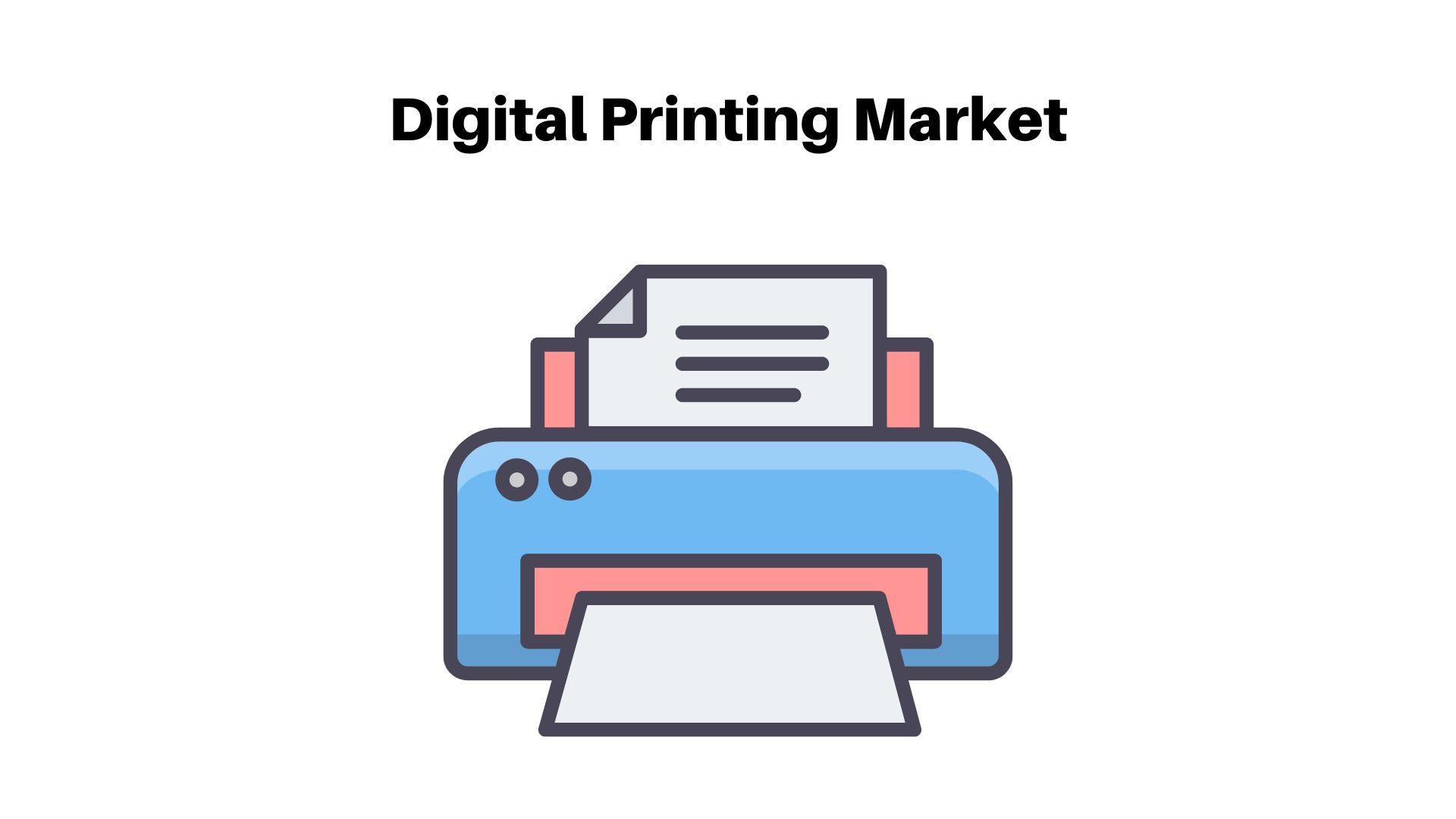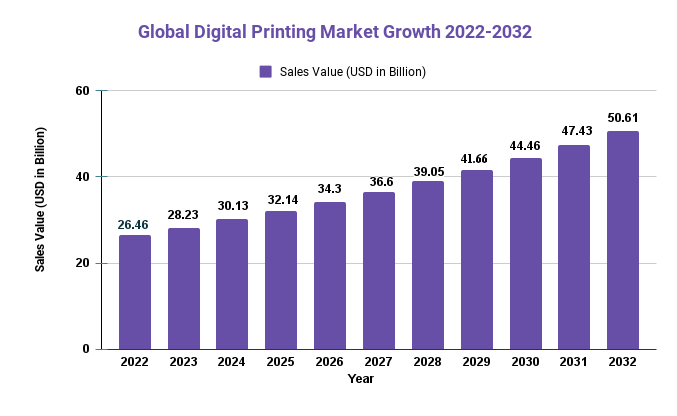Digital Printing Market Analysis (USD 50.61 billion) | Development Ideas By 2032

Page Contents
Market Overview
Digital printing is a modern printing technology that utilizes electronic files to print directly on various substrates. This method has several advantages over traditional methods, such as greater versatility, faster turn-around times, and lower costs. In 2022, the global digital printing market was valued at USD 26.46 billion; projected to increase at a compound annual growth rate of 6.7% between 2022-2032 to reach an impressive USD 50.61 billion by 2032.
Digital printing is the process of directly printing digital files onto various substrates such as paper, fabric, and plastic. Compared to traditional printing methods, digital printing provides several advantages such as faster turnaround time, lower setup costs, and the capacity for smaller quantities. The global digital printing market is expected to experience a compound annual growth rate (CAGR) of 6.7% from 2022-2032 due to factors such as increasing demand from industries like advertising, packaging, and textile; accessible cost-effective digital printing technologies; and growing adoption within packaging applications.
Get a Preview PDF of the Report here >> https://market.us/report/digital-printing-market/request-sample/

The printing technology, application, and geography segment the market. Based on printing technology, there are two primary types: inkjet printing and laser printing. Inkjet printing is expected to hold the majority share during the forecast period due to its superior quality output on various substrates. Application-wise, there are four main segments: advertising, packaging, textile & others – with packaging expected to have the largest share due to growing demand for high-quality packaging printing for branding & marketing campaigns.
Geographically, North America is expected to dominate the digital printing market during the forecast period due to several key players in the region and the growing demand for digital printing across various industries. On the other hand, Asia Pacific will experience rapid growth during this time due to the increasing adoption of digital printing technologies in emerging economies like China and India. Overall, analysts anticipate that the digital printing market size will continue to expand over the coming years, driven by rising demands for high-quality printing across various sectors and cost-effective digital printing technologies.
Key Takeaways
The digital printing market is being driven by rising demand for variable data printing and expanding adoption of digital printing technologies across various industries.
The Asia Pacific region is expected to experience the highest growth rate in the digital printing market, due to rising demand for these technologies in emerging economies such as China and India.
The industrial digital printing segment is expected to experience strong growth due to an increasing need for packaging and labeling solutions across numerous industries.
Regional Snapshot
North America led the global digital printing market in 2022 and is expected to remain in this position throughout the forecast period. This growth can be attributed to the increasing adoption of digital technologies across various industries such as packaging, advertising, and textiles. Asia Pacific is expected to experience the highest growth rate within this space due to rising demand from
emerging economies like China and India for these services. Europe is forecasted to experience moderate expansion due to increasing use of digital printing techniques within the packaging industry.
Drivers
- Rising demand for variable data printing
- Growing adoption of digital printing technologies across various industries
- Benefits offered by digital printing, such as flexibility, quicker turnaround times, and lower costs, are driving this demand upwards.
- Packaging and labeling solutions are in high demand across various industries due to technological advancements in digital printing.
Restraints
- The high initial investment required for digital printing equipment
- Limited compatibility with certain substrates
- Lower quality of prints compared to traditional methods
- Environmental concerns regarding the disposal of digital printing consumables.
Before obtaining this report, contact the seller at >> https://market.us/report/digital-printing-market/#inquiry
Opportunities
Personalization – Digital printing allows for customization and personalization of printed materials, making it ideal for targeted marketing campaigns, personalized packaging, and more.
Short Print Runs – Digital printing has the advantage of producing smaller print runs more cost-effectively, which makes it ideal for small businesses or those who require frequent updates to their printed materials.
Faster turnaround time – Digital printing doesn't require the setup time or plate-making that traditional methods require, resulting in quicker completion times for printing projects.
Variable Data Printing – Digital printing makes it possible to customize the content of each printed piece, enabling highly targeted marketing campaigns.
Challenges
- Quality Issues – Although digital printing has made great strides over the years, some still contend that it does not produce the same level of output as more traditional methods.
- Cost Effectiveness – Digital printing can be cost-effective for short print runs, but may become prohibitively expensive for larger runs.
- Limited Material Options – Due to its specific materials such as paper and plastics, digital printing may only work well with certain types of materials and not be compatible with others.
- Limited Color Range – Some digital printing methods offer a more limited color selection than traditional methods.
Recent Advancements
Improved Quality – Digital printing technology has progressed to the point where it can produce prints of comparable quality to traditional methods.
Expanded Material Options – New digital printing techniques offer the versatility to print on a range of materials, such as metals, glass, and fabrics.
Eco-Friendly Choices – Some digital printing processes use eco-friendly inks and processes for greater sustainability; making them more sustainable choices for consumers.
3D Printing (3D printing) – 3D printing is a digital printing technology that enables the creation of three-dimensional objects.
Key Market Segments
Type
- Aqueous
- Solvent
- UV-curable
- Latex
- Dye sublimation
Application
- Plastic films or foils
- Release liner
- Glass
- Textile
- Paper
- Ceramic
Key Market Players included in the report
- Hewlett-Packard
- Canon
- Ricoh Company
- Mimaki Engineering
- RoLAnd Dg Corporation
- Xerox Corporation
- Seiko Epson Corporation
- Durst Phototechnik AG
- Electronics for Imaging
- Inca Digital Printers Limited
Report Scope
| Report Attribute | Details |
| The market size value in 2022 | USD 26.46 Bn |
| Revenue forecast by 2032 | USD 50.61 Bn |
| Growth Rate | CAGR Of 6.7% |
| Regions Covered | North America, Europe, Asia Pacific, Latin America, and Middle East & Africa, and Rest of the World |
| Historical Years | 2017-2022 |
| Base Year | 2022 |
| Estimated Year | 2023 |
| Short-Term Projection Year | 2028 |
| Long-Term Projected Year | 2032 |
Frequently Asked Questions
Q: What is the difference between digital printing and traditional printing?
A: Digital printing does not require the creation of printing plates, as the image is sent directly to the printer. Traditional methods, such as offset printing, require the creation of plates and a more involved printing process.
Q: What is variable data printing?
Variable data printing is a type of digital printing that enables the customization of printed materials by altering the content within each piece printed.
Q: What materials can be printed using digital printing?
A: Currently, digital printing is best suited for paper and plastic materials; however, new methods are emerging that enable printing on metal, glass, and fabrics as well.
Q: Is digital printing cost-effective for large print runs?
A: That depends on the project and printing method being used; generally speaking, digital printing may prove expensive when producing long-run pieces.
Q: What is 3D printing?
3D printing is a type of digital printing that enables the creation of three-dimensional objects.
The team behind market.us, marketresearch.biz, market.biz and more. Our purpose is to keep our customers ahead of the game with regard to the markets. They may fluctuate up or down, but we will help you to stay ahead of the curve in these market fluctuations. Our consistent growth and ability to deliver in-depth analyses and market insight has engaged genuine market players. They have faith in us to offer the data and information they require to make balanced and decisive marketing decisions.



